For centuries, the mesmerizing scent of blood drew crowds to the hundreds of amphitheaters scattered throughout the Roman Empire. The audience's desires, met with difficulty, led to an escalation of the perversion and cruelty of the Games. What methods did the organizer have to use to attract viewers to his show?
1. Take care of marketing
A few days before the performance, the walls of narrow streets were covered with blood red posters with a short description of the professions. Here is the content of one of the preserved ones: 5. On October 6th, 20 pairs of gladiators will compete in Kyme. The show will be accompanied by the crossing of convicts and fights with wild beasts .
To the moralists' indignation, these screaming announcements were not hesitated to put even on roadside tombstones. When the gladiators were eating their last meal in front of the spectators on the eve of the performance, people were given autographs carved on clay swords and lamps in the shape of gladiators' helmets.
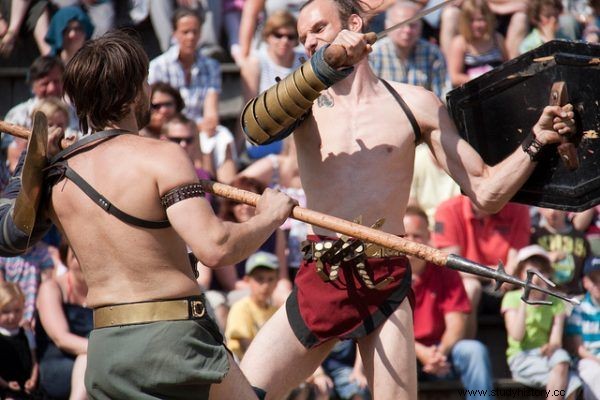
But it certainly wasn't about having fun (photo by Hans Splinter, CC BY-ND 2.0).
Local producers quickly caught a good deal of it. Countless everyday objects were decorated with motifs of bloody sport. The least obvious ones include ... a terracotta baby bottle found in Pompeii.
2. Surround your viewers with luxury
Once the audience was in the stands, one surefire way to charm them was to keep them comfortable and with a touch of luxury. Velum - a canvas roof stretched over the stands on hot days - it did not make a big impression on anyone . As Seneka recalls, on special occasions a refreshing mist was sprayed over the heads of the audience ( sparsio ), sometimes with a scent of precious spices.
It was best to guess the nature of the Roman people who decided to give them. Emperor Titus Flavius, in order to celebrate the opening of the Colosseum, ordered wooden balls-lots to be thrown towards the audience. They had all kinds of rewards engraved on them, from food and jewelry to quite plump slaves.
His brother Domitian did the same when he showered the audience in the Colosseum with a rain of exotic fruit, goodies and rare birds. Favors for gifts, the plebs fought regular battles for them, which in itself could be a predicted attraction.
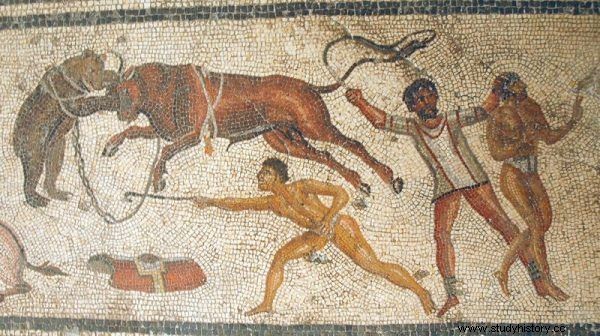
Fighting with animals could turn into a hunting for spectators (fragment of a mosaic found in the city of Zliten in Libya).
Also fighting with animals ( venationes ) seldom turned into active entertainment for the people. Emperor Probus, on the occasion of his triumph over the Germanic tribes, ordered one of the Roman circuses to be transformed into a park, where hundreds of exotic animals walked freely. Every lucky man had a right to what he hunted.
Finally, to create a theatrical atmosphere, the arena shows were accompanied by rich illuminations and simple music, which set the rhythm of the fights.
3. Save money:place an execution
The way to reduce the cost of hiring gladiators was to conduct public executions. Interestingly, the imperial administration for a small fee (the tax was announced in the imperial edict of 177) sent out surplus convicts ( damnatii ad bestias et ad ludum ) to the province.
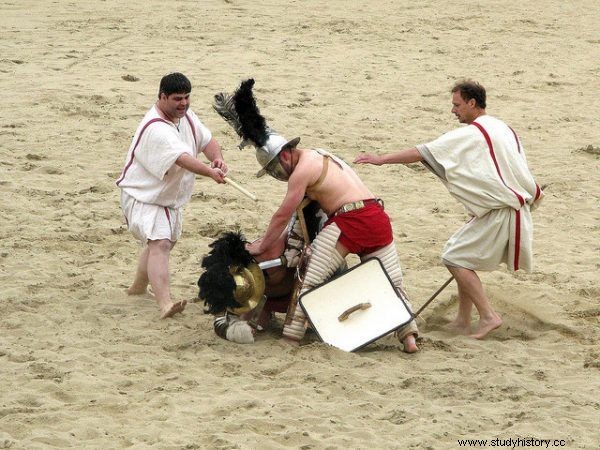
The judges constantly monitored the rules (photo:Michael, CC BY-ND 2.0).
In front of the audience, the unfortunates were subjected to elaborate torture, and then crucified, thrown to hungry predators to be eaten, torn by horses or roasted alive on iron thrones . The so-called tunica molesta , i.e. a robe soaked in flammable material, in which a condemned man was tied to a stake. Nero lit the Vatican gardens with such human torches during the persecution of Christians in AD 64.
4. Be creative. Crucifixion may not be enough
Only exceptionally, the execution turned into a sophisticated staging. If you believe Marcjalis and his "Book of spectacles" ( Liber spectaculorum ) the opening of the Colosseum was graced with a series of bloody mythological scenes. In one of them, a woman immobilized in a wooden cow was forced to mate with a bull . Thus, she played the role of Queen Pazyfae, who gave birth to the monstrous Minotaur.
The poet also mentions a convict who happened to play a famous episode from the early history of Rome. Following the example of Mucjusz Scewola, he put his hand into the fire. The historical Scewola thus showed bravery in the face of the Etruscan king-occupier, the punished man only entertained the Roman public in this way
Tertullian, a Christian and an implacable critic of Roman religion, also wrote about the mythologization of the spectacles. According to his message, the audience could watch the self-castration of the unfortunate man playing a scene from the myth of the goddess Cybele in the arena and her lover Attica . This young man deprived himself of his masculinity in order to devote himself fully to the goddess. Historians believe that in this case the condemned man was faced with a painful choice - either birth or death.
5. Have a cabaret
It happened that in the intervals between serious clashes, bows were made to the heavy sense of humor of the Romans. In the times of the republic, as Cicero attests, one could see people fighting in the arena wearing helmets blindfolded ( andabatae ). That grotesque sight of a group of convicts beating blindly amused the audience immensely.
It was similar in the case of Domitian's favorite fights between dwarfs and crippled people . There was a separate category of comedians called paegniarii . Their performances were a parody of different styles of gladiatorial fighting.
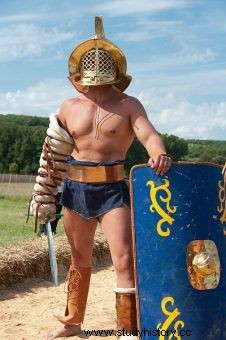
A proud murmillo (one of the types of gladiators), perhaps after defeating his traditional opponent:Thracian (photo:Curiosito, CC BY-SA 3.0).
6. Hire Professionals
Most viewers, however, came to the amphitheater to admire the professionals. It would be an abuse to call them duels to the death, however. . A slave trained in a gladiatorial school, if he survived the first few fights, became too valuable for the owner to freely waste his life.
Thanks to painstaking research, the eminent historian Georges Ville concluded that in the first century C.E. out of one hundred duels, about twenty ended in death, and therefore every tenth player taking part in them died. Considering that the average gladiator fought two to three fights a year, he had a good chance of reaching a right age. Surrounded by excellent medical care, a staff of specialists (masseurs etc.), fed better than the average Roman, he did not have to follow the gloomy fate of a condemned man.
The audience, on the other hand, did not always hunger for blood . In gladiatorial fights, she was able to appreciate the technical skills and ambition of individual players. In fact, they fought in accordance with the rules, and the umpires supervised their observance. They stopped the fight when one of the contestants was unable to continue it.
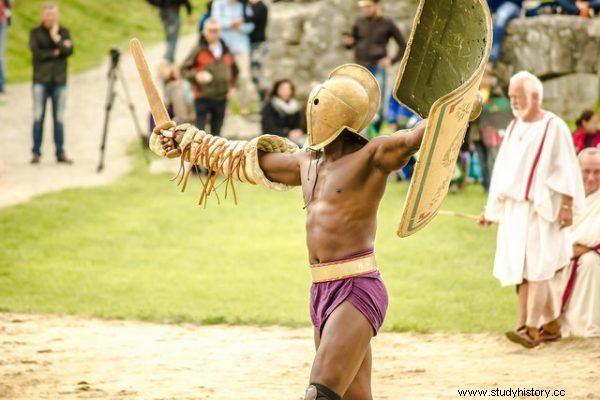
Some gladiators became real stars (photo:Clemens Schleinzer, CC BY-ND 2.0).
The richer gladiators could even afford an epitaph to commemorate their lives. Of course, a short inscription carved in stone could not omit the balance of achievements:the number of fights or the laurels won. On the tombstone of a certain Urbicus, who died in his thirteenth fight, there is a bitter advice for his inexperienced colleagues:" I advise you to kill those you have knocked down ”.
7. Download a real star
Only a handful of lucky people achieved the status of true stars thanks to their charisma and skill. It was their images that decorated the walls of porticoes and public baths, as well as the aforementioned equipment of Roman houses. Sometimes they went on a real tour . Subsequent cities competed then in granting them honorary laurels and citizenships.
No wonder the stands were boiling at the mere mention of their nicknames. What about when the great comeback was taking place! Nero, in order to convince one of the veterans to return, reportedly promised him the fallen senator's palace . Therefore, there were many real fanatics among the fans.
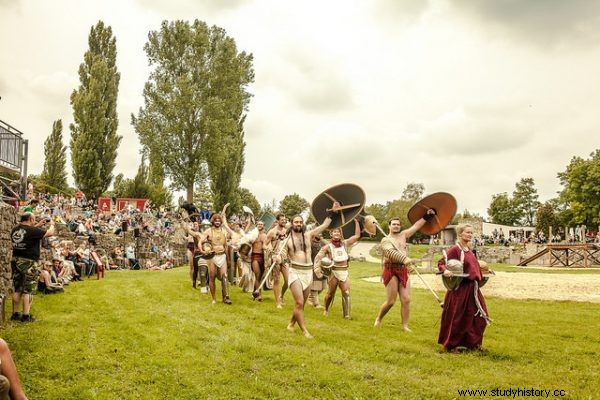
Ave Caesar! Morituri te salutant! In fact, it was probably not the traditional gladiatorial salute. It appears in the sources in reference to only one situation (photo:Clemens Schleinzer, CC BY-ND 2.0).
In extreme cases, this fascination led to the ascribing of magical qualities to gladiators. The aforementioned Tertullian saw with his own eyes people collecting blood gushing from a gladiator's slit throat to use it as a cure for epilepsy. In the same context, the imperial physician Scribonius Largus even mentions consuming the liver of a stage warrior.
***
The organization of the gladiatorial games was a constant game between the public and the founders, which took the form of a real auction for innovation and cruelty. No wonder the emperors sought to monopolize the right to organize the Games, seeing them as a powerful tool of propaganda and social control.
Bibliography:
- Roland Auguet, Cruaut é et civilization. Les jeux romains , Flammarion, Paris 1970.
- David L. Bomgardner, The Story of the Roman Amphitheater , Routledge, London – New York 2000.
- Mary Beard, Keith Hopkins, The Colosseum , Profile Books, London 2005.
- K [athleen]. M. Coleman, Fatal Charades. Roman Executions Staged as Mythological Enactments , "The Journal of Roman Studies," vol. 80 (1990), pp. 44-73.
- Peter Connolly, Rome's Arena of Death , BBC Books, London 2003.
- Alison Futrell, The Roman Games. Historical Sources in Translation , Blackwell Publishing, Oxford 2006.
- George Jennison, Animals for Show and Pleasure in Ancient Rome , Manchester University Press, Manchester 1937.
- Robert Knapp, Invisible Romans , Profile, London 2011.
- Donald G. Kyle, Spectacles of Death in Ancient Rome , Routledge, London – New York 1998.
- Konstantin Nossov, Rome's Bloody Spectacle , Osprey Publishing, Oxford 2009.
- Paul Plass, The Game of Death in Ancient Rome , University of Wisconsin Press, Wisconsin 1995.
- Thomas E.J. Wiedemann, Emperors and Gladiators , Routledge, London – New York 1992.
